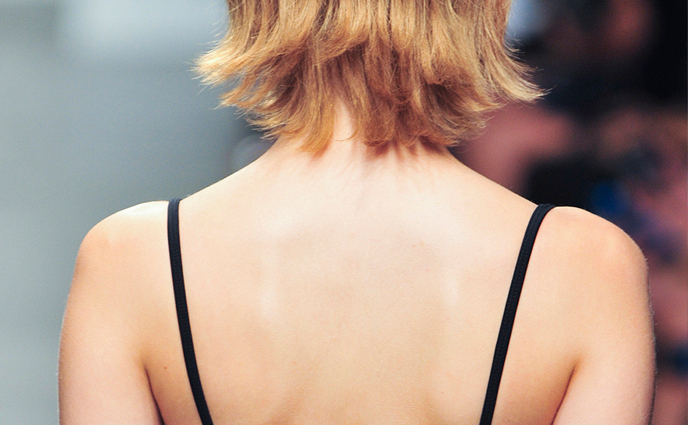Pimples are always a PIA, but they're not all alike. The blanket term "acne" or "pimple" really applies to a range of skin imperfections.
Your acne is considered mild if you have comedones, aka blackheads and whiteheads. Blackheads are blemishes that aren't under the skin and look like tiny, dark-colored spots. Whiteheads are closed blemishes that appear as small bumps in the skin.
Papules, a sign of moderate acne, are slightly larger bumps that occur when bacteria infects the hair follicle. They may become filled with pus.
Hard, swollen bumps that are painful to the touch are known as nodules, and these are a sign that your acne is severe. Cysts are like nodules -- large, painful bumps -- that are filled with pus.
Your Rx: If you have comedones, that's a sign that drugstore products with benzoyl peroxide or salicylic acid will clear them. If you have papules or nodules, you might need a dermatologist's help.
Your acne is considered mild if you have comedones, aka blackheads and whiteheads. Blackheads are blemishes that aren't under the skin and look like tiny, dark-colored spots. Whiteheads are closed blemishes that appear as small bumps in the skin.
Papules, a sign of moderate acne, are slightly larger bumps that occur when bacteria infects the hair follicle. They may become filled with pus.
Hard, swollen bumps that are painful to the touch are known as nodules, and these are a sign that your acne is severe. Cysts are like nodules -- large, painful bumps -- that are filled with pus.
Your Rx: If you have comedones, that's a sign that drugstore products with benzoyl peroxide or salicylic acid will clear them. If you have papules or nodules, you might need a dermatologist's help.
Oh, the sun. It sucks for your body in so many ways. Here's another one: The sun makes marks left from pimples worse by increasing the level of pigmentation in skin, so they take much longer to fade. (Grumble, grumble.)
Your Rx: Never go outside without broad-spectrum sunscreen. "The best ones to look for are zinc [oxide] or titanium [dioxide] sunblocks that have a tint, so they protect and cover at the same time," Tanzi says.
Tanzi likes the "light and noncomedogenic" L'Oréal Advanced Suncare Silky Sheer BB Face Lotion 50+ and La Roche-Posay Anthelios 50 Mineral Tinted Ultra Light Sunscreen Fluid.
Your Rx: Never go outside without broad-spectrum sunscreen. "The best ones to look for are zinc [oxide] or titanium [dioxide] sunblocks that have a tint, so they protect and cover at the same time," Tanzi says.
Tanzi likes the "light and noncomedogenic" L'Oréal Advanced Suncare Silky Sheer BB Face Lotion 50+ and La Roche-Posay Anthelios 50 Mineral Tinted Ultra Light Sunscreen Fluid.
Vitamin E is in avocados, papaya, olive oil and so many other magnificent things. But the very ingredient that makes you look hydrated and glow-y is hell on acne.
Researchers at the University of Miami found that vitamin E inhibits scar healing for 90 percent of patients (yowza). In the study, vitamin E caused contact dermatitis in one third of these patients.
Your Rx: Steer clear of products that boast vitamin E on their ingredient labels. (You might see it referred to as alpha-tocopherol.) Taking it orally in supplement form is A-OK.
Researchers at the University of Miami found that vitamin E inhibits scar healing for 90 percent of patients (yowza). In the study, vitamin E caused contact dermatitis in one third of these patients.
Your Rx: Steer clear of products that boast vitamin E on their ingredient labels. (You might see it referred to as alpha-tocopherol.) Taking it orally in supplement form is A-OK.
Some of the most bacteria-laden objects in your environment are the ones that receive the most contact with your hands. In fact, your cellphone is one of the most pathogen-infested things you touch on a daily basis, notorious among dermatologists for its bacteria-transferring abilities.
"The area from the temple to the chin [is] referred to as the 'phone zone,'" says Frank. "Your phone holds onto germs and these germs can be transferred onto your skin."
Your Rx: Keep a box of antibacterial wipes in your desk or car caddy so you remember to wipe down your device a few times a week. Frank recommends regular exfoliation to unclog pores and lessen the likelihood that bacteria transferred from your phone will lead to a breakout.
"The area from the temple to the chin [is] referred to as the 'phone zone,'" says Frank. "Your phone holds onto germs and these germs can be transferred onto your skin."
Your Rx: Keep a box of antibacterial wipes in your desk or car caddy so you remember to wipe down your device a few times a week. Frank recommends regular exfoliation to unclog pores and lessen the likelihood that bacteria transferred from your phone will lead to a breakout.
Deep, "icepick" acne scars -- the ones that look like little crevices in the skin -- are some of the most difficult to treat. One of the most powerful solutions: Get rid of the skin altogether.
"In punch excision surgery, deep scars are treated using a punch biopsy tool," explains Peredo. Essentially, the dermatologist punches a hole in the skin just large enough to remove the affected skin. "Then, skin can either be sutured together or grafted with skin from behind the ear," says Peredo.
Your Rx: If you have mild to moderate icepick scarring, ask your dermatologist if you're a candidate for excision. Another option: Have your doctor inject the scar with fillers like Juvederm. The results are more temporary than punch excision, but they're immediate and the process is less invasive.
"In punch excision surgery, deep scars are treated using a punch biopsy tool," explains Peredo. Essentially, the dermatologist punches a hole in the skin just large enough to remove the affected skin. "Then, skin can either be sutured together or grafted with skin from behind the ear," says Peredo.
Your Rx: If you have mild to moderate icepick scarring, ask your dermatologist if you're a candidate for excision. Another option: Have your doctor inject the scar with fillers like Juvederm. The results are more temporary than punch excision, but they're immediate and the process is less invasive.
What causes acne, how to prevent acne from forming, and how to treat existing acne are three of the most mystifying issues in dermatology today. That's because acne can be influenced by such a weird amalgamation of factors -- from major influences like lifestyle, heredity and stress down to seemingly insignificant details like what you pour over your cereal in the morning. Here's everything we know about acne and how to cure it, from the foods that cause acne to pimple home remedies to antibiotics for acne.




